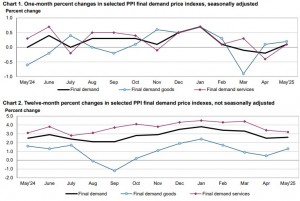June 12, 2025
The Producer Price Index (PPI) for final demand in the U.S. rose 0.1 percent in May on a seasonally adjusted basis, according to the U.S. Bureau of Labor Statistics. Final demand prices had declined 0.2 percent in April and 0.1 percent in March. Over the 12 months ended May 2025, the index for final demand increased by 2.6 percent on an unadjusted basis.
In May, the increase in the index for final demand was primarily driven by a 0.1 percent rise in prices for final demand services, while prices for final demand goods increased by 0.2 percent.
Excluding foods, energy, and trade services, the index for final demand edged up by 0.1 percent in May, following a 0.1 percent decline in April. Over the past 12 months, this index has advanced by 2.7 percent.
Final demand goods
In May, the index for final demand goods rose 0.2 percent, following a 0.1 percent increase in April. Prices for final demand goods excluding foods and energy also advanced by 0.2 percent, accounting for over 80 percent of the overall increase. Prices for final demand foods edged up 0.1 percent, while the index for energy remained unchanged.
A key contributor to the May increase was a 0.9 percent rise in prices for tobacco products. Additional gains were recorded in gasoline, processed poultry, roasted coffee, residential natural gas, and oilseeds. These increases were partially offset by an 8.2 percent decline in jet fuel prices, along with decreases in the indexes for pork and carbon steel scrap.
Final demand services
In May, the index for final demand services inched up 0.1 percent, reversing part of the 0.4 percent decline seen in April. This increase was largely driven by a 0.4 percent rise in margins for final demand trade services. Prices for transportation and warehousing services fell by 0.2 percent, while the index for services excluding trade, transportation, and warehousing was unchanged.
Leading the increase were margins for machinery and vehicle wholesaling, which surged 2.9 percent. Other notable gains were seen in traveler accommodation services; apparel, footwear, and accessories retailing; alcohol retailing; and system software publishing. Offsetting these gains were declines in airline passenger services (down 1.1 percent), furniture retailing, securities brokerage and investment services, and portfolio management.

Disclaimer:
Analyst Certification – The views expressed in this research report accurately reflect the personal views of Mayberry Investments Limited Research Department about those issuer (s) or securities as at the date of this report. Each research analyst (s) also certify that no part of their compensation was, is, or will be, directly or indirectly, related to the specific recommendation(s) or view (s) expressed by that research analyst in this research report.
Company Disclosure – The information contained herein has been obtained from sources believed to be reliable, however its accuracy and completeness cannot be guaranteed. You are hereby notified that any disclosure, copying, distribution or taking any action in reliance on the contents of this information is strictly prohibited and may be unlawful. Mayberry may effect transactions or have positions in securities mentioned herein. In addition, employees of Mayberry may have positions and effect transactions in the securities mentioned herein.





